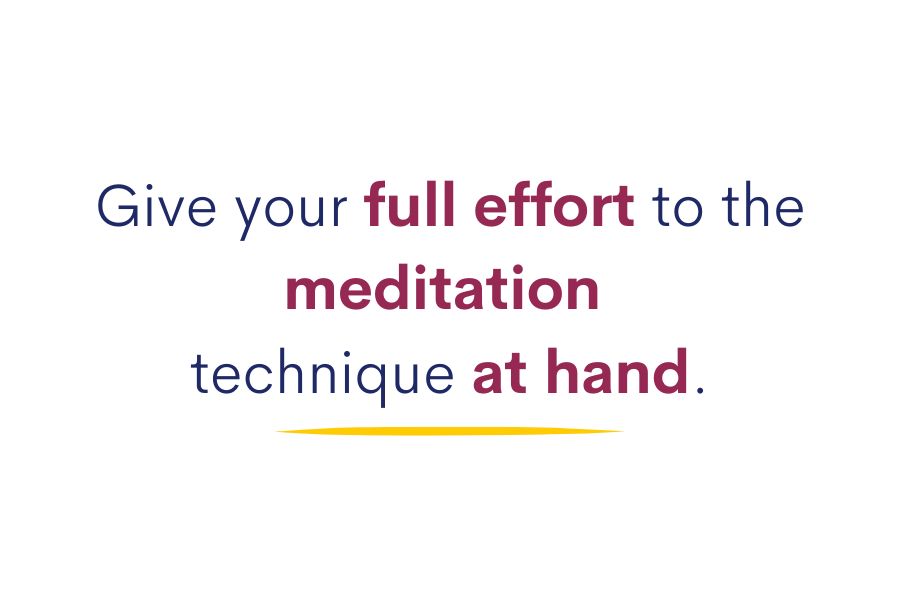Starting or refreshing your meditation practice can be overwhelming. So, we’ve compiled some common questions and issues that students and teachers discuss at our retreats. Let’s begin with some meditation tips!
How do I start meditating?
When you’re a beginner to meditation, focus on one practice at a time. It’s tempting to try to learn tons of practices at once, but there’s a lot of value in doing one thing at a time. We know that multi-tasking isn’t efficient, and it’s similar with meditation practice. In calm abiding, for example, you are only trying to focus your mind single-pointedly on an object, and if you are shifting your attention to other things like observing sensations or trying to see their impermanence, emptiness, and so forth, you are not practicing calm abiding.
Give your full effort to the meditation technique at hand. This is also important in how you discuss your practice with your teacher. If you’re practicing calm abiding, but in your interview, you talk about many different practices, your teacher won’t be able to give you clear advice on how to improve in your calm abiding practice. So, both in the way you practice and the way you discuss your practice, stick with the practice just as it was taught to you.
Here’s another way to think about it. If you are sick and want to get better, you need to see a doctor. Once you’ve seen a doctor, you need to take the medicine they have prescribed in the manner they directed. Getting their advice and not acting on it probably won’t lead to getting better. Similarly, you have a dharma teacher and received their advice and instructions, so it’s important to put those into practice. When you do, make a great effort to practice them just as they were taught without mixing them with other methods you’ve read or heard elsewhere.
In the example above, it’s like seeing a doctor, getting their prescriptions, and then proceeding to research your illness on YouTube or WebMD. And we all know the black hole that can be, right?! Then you could end up doing other practices which may or may not be of any benefit to the practice you’re currently trying to learn. Our minds swirl with more than enough distraction on the cushion as it is. The more simple and focused we can make our course of practice, the more focused each meditation can be.
How can I find the motivation for meditation?
Be patient with yourself and resist harshly judging yourself. A little gentleness with yourself can go a long way. All of us have been habituated to non-stop distraction and thinking for our whole lives (as well as in our past lives). You can’t expect to be able to overcome that in just a few days, weeks, or even months of meditation. When you get distracted in meditation, notice that you are distracted and immediately come back to your object. Resist judgment and criticism. Instead, you could slightly celebrate, thinking, “Though I almost never notice my constantly roaming mind, just now I had enough awareness to catch it in the act!” Then enjoy another mini celebration at not having to think about that (or anything else) right now, and settling into the fresh stillness of Shamata.
Self-critical thoughts are more thinking, a/k/a further distraction and only reinforce our habituation to thinking. Noticing that we are distracted, and immediately returning to our object increases the power of our mindfulness and alertness. The more we do that, the less power distracting thoughts have over us—at first on the cushion, and later, in everyday life!
What do I need to know about meditation?
Of course, we can’t give you everything you need to know about meditation in one blog. But you will want to be aware of meditative experiences. If you have some good experiences of stability, clarity, joy, non-conceptuality and so forth, know that your next session may not be the same. That expectation itself will prevent you from being entirely focused on your practice. Yet that very focus is what will bring about a stable meditative state where such experiences can occur. So, ironically, if you want the good experiences, release the hope or expectation that those experiences may occur and focus entirely on the technique itself, with single-pointed focus. If you begin having such experiences regularly, it is important to share that with your teacher and receive further instructions.
Last and perhaps the most important of the tips: as students progress along the Vajrayana path, we recommend that they work closely with and receive teachings from qualified teachers. HOW do we best do that?
Tips for Working with a Spiritual Teacher
In the classical Buddhist texts, it is said that there are three ways to delight your teacher. The first and most basic way is by giving material gifts of food, clothing, and so forth. The second is to offer your assistance or service. This could include cleaning a classroom or temple, making dinner, helping organize teachings, and so on. The third and supreme way is to do your practice.
Your teacher has devoted their life to helping students to wake up—a work that is near and dear to their heart. If you do your practice, then what else could make them happier? Their life is being well spent.
As one of our translators, Justin Kirkwood, said, “In all my 10-plus years of translating for private interviews or one-on-one sessions for many Tibetan Buddhist teachers, I have never seen my teachers more pleased than when a student comes for an interview and says that they have been consistently doing the practice they were given and asks for advice and further clarification about it, rather than asking for job or general lifestyle advice, or talking about a wondrous dream or vision they had.”
That doesn’t mean that there is never a time in your relationship with a teacher to ask for other kinds of advice. Often your time during a retreat is very limited, so it’s ideal to stay focused on your teacher’s specialty. n. At most of our retreats with Khen Rinpoche, students are given an opportunity to meet with him one-on-one to ask questions and get advice. The guidelines here were developed specifically for those sessions but may also be applied to working with a spiritual teacher.
1.) Try to keep your questions focused on the current stage of practice you are working on from the instructions you have received from that teacher.
2.) If you are meeting a teacher for the first time, give them a brief summary of your practice experience and studies, and what other teachers or traditions you have studied.. You don’t need to and normally don’t have time to share your whole life story. Try to keep it to basically a short meditation résumé, so they can get a sense of where you are in your practice experience and how they can help you. If you’re part of or joining a sangha, you can all share your life stories there to your hearts’ content!
3.) If the techniques of a practice are unclear, asking for those details is critical. If you feel stuck in terms of becoming more focused (less distracted) or more clear-minded, you’ll want to ask about that or any obstacles you’re experiencing.
4.) When your teacher asks how your practice is going or how your mind is feeling during your practice, what they want to know is: How long can you stay with the object before you get distracted? When thoughts come up, can you quickly return to the object, or do you get caught up in them? What are the qualities of your mind in meditation? For example, is your mind feeling vibrant, sharp, alert, clear, or maybe dull, sleepy, unclear, open, closed, etc.? If you are working with a visualization, how clear is it? Do you feel that the lama/deity/buddha is actually there or does it feel contrived?
If you try all of these tips and work from these understandings, we are sure you’ll find that your practice progresses all the more quickly, will be more satisfying, and you’ll enjoy the rewards of it in all areas of your life. Keep an eye on our events and join a Learning Circle to start practicing with others!
We’d love to hear your questions or tips that have been helpful to you. Send them our way and email info@namchak.org.


